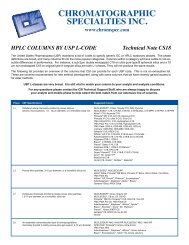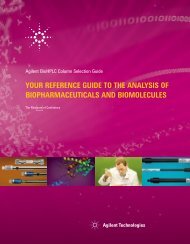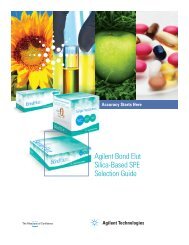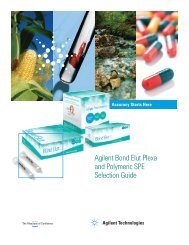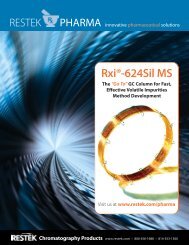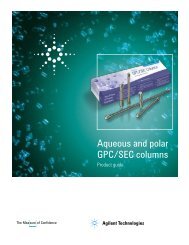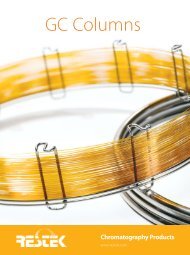Optimizing the Analysis of Volatile Organic Compounds
Optimizing the Analysis of Volatile Organic Compounds
Optimizing the Analysis of Volatile Organic Compounds
Create successful ePaper yourself
Turn your PDF publications into a flip-book with our unique Google optimized e-Paper software.
Adsorbent Materials<br />
Tenax ® Adsorbent (surface area: 50m 2 /g): Tenax ® adsorbent is excellent for trapping nonpolar<br />
compounds and is hydrophobic so it does not retain water; however, it does have some<br />
disadvantages. Very volatile compounds are not retained well and must be trapped on a<br />
stronger adsorbent material. In addition, polar compounds like alcohols are poorly retained<br />
on this adsorbent. Tenax ® adsorbent also has limited <strong>the</strong>rmal stability; <strong>the</strong> 2,6-diphenyleneoxide<br />
polymer <strong>the</strong>rmally decomposes into toluene, benzene, and o<strong>the</strong>r aromatics. The particles<br />
melt toge<strong>the</strong>r and permanently adhere to <strong>the</strong> trap; this <strong>the</strong>n restricts carrier gas flow.<br />
As <strong>the</strong> adsorbent degrades, <strong>the</strong>re <strong>of</strong>ten is a loss in response for brominated compounds.<br />
There are two grades <strong>of</strong> Tenax ® adsorbent used as a trapping material: Tenax ® GC and<br />
Tenax ® TA (Trapping Agent) adsorbents. Common background contaminants in Tenax ® GC<br />
adsorbent include benzene and toluene. Tenax ® TA adsorbent is a purer form and is more<br />
commonly recommended for <strong>the</strong>rmal desorption applications. The manufacturer’s recommended<br />
operating temperature is 230°C but, realistically, <strong>the</strong> material performs best when<br />
kept below 200°C. Samples that contain organic acids can degrade Tenax ® adsorbent. This<br />
effect is more pronounced at higher temperatures; for longer trap life and better consistency<br />
do not use traps containing this adsorbent at temperatures above 200°C.<br />
Silica Gel (surface area: 200-800m 2 /g): Silica gel is a stronger adsorbent than Tenax ®<br />
adsorbent. Silica gel is commonly used in conjunction with Tenax ® adsorbent as a trap for<br />
volatile organic pollutants. It is an excellent trapping material for polar and highly volatile<br />
compounds that are gases at room temperature; however, silica gel is extremely hydrophilic<br />
and will retain large amounts <strong>of</strong> water. Be aware that if a trap contains silica gel, dry purging<br />
will not reduce <strong>the</strong> water content.<br />
Coconut Charcoal (surface area: 900m 2 /g): Coconut charcoal is ano<strong>the</strong>r strong adsorbent<br />
material. It is commonly used in series after silica gel for trapping very volatile compounds<br />
that might break through <strong>the</strong> gel. Coconut charcoal is hydrophobic, and does not retain significant<br />
amounts <strong>of</strong> water. It does, however, trap carbon dioxide (CO2) purged from <strong>the</strong> sample,<br />
and it has been reported that charcoal is a source <strong>of</strong> CO2, which can interfere with <strong>the</strong><br />
quantitation <strong>of</strong> early-eluting compounds when using GC/MS systems.<br />
Graphitized Carbon Black or Carbopack ® Adsorbent (surface area: 10-100m 2 /g):<br />
Graphitized carbon black (GCB) is an alternative to Tenax ® adsorbent. GCB is available in<br />
many pore sizes and is effective in trapping volatile organics in <strong>the</strong> same range as Tenax ®<br />
adsorbent. GCB is hydrophobic and has excellent <strong>the</strong>rmal stability, making it ideal for purge<br />
and trap techniques. Highly volatile compounds are not retained well on GCB and must be<br />
trapped on stronger adsorbent materials such as carbon molecular sieves.<br />
Carbon Molecular Sieves (surface area: 50-800m 2 /g): Carbon molecular sieves such as<br />
Carbosieve -SIII are alternatives to silica gel and charcoal. High surface areas make <strong>the</strong>se<br />
materials ideal for trapping highly volatile compounds. They are commonly used in series<br />
after GCB because <strong>the</strong>y retain compounds that break through <strong>the</strong> GCB. Carbon molecular<br />
sieves are hydrophobic and have excellent <strong>the</strong>rmal stability.<br />
Carboxen ® -1000 Adsorbent (surface area: 1200m 2 /g): Carboxen ® -1000 adsorbent is a<br />
strong adsorbent designed to be used as <strong>the</strong> innermost adsorbent bed in <strong>the</strong> trap (Figure 8,<br />
page 12). This material traps Freon ® compounds, permanent gases, and light hydrocarbons.<br />
It has characteristics very similar to those <strong>of</strong> Carbosieve ® S-III packing material. Carboxen ® -<br />
1000 adsorbent is stable to temperatures <strong>of</strong> 300°C. Its only shortcoming is <strong>the</strong> adsorption <strong>of</strong><br />
CO2, which can interfere with early-eluting compounds. 2 Carboxen ® -1001 and Carboxen ® -<br />
1002 are similar materials.<br />
2. Mosesman, N.H., W.R. Betz, and S.D. Corman. "Alternate Trapping Materials for Purge-and-Trap<br />
<strong>Analysis</strong> <strong>of</strong> <strong>Volatile</strong> <strong>Compounds</strong>." Proc.-Water Qual. Technol. Conf. Adv. Water Anal. Treat..<br />
14 (1987): 245-50.<br />
11<br />
www.restekcorp.com





